How to use Password Agent with Google Drive
Note: We recommend to use Microsoft OneDrive or other cloud software that supports Windows Cloud API instead of Google Drive on Windows because of better integration and ease of use. You can use Google Drive, but since it is not integrated with Windows Cloud API, Password Agent treats Google Drive files as usual files and specific cloud file functions like out of sync notifications are not available.
This document helps you to set up Google Drive on Windows, so you can synchronize Password Agent files with different devices. If you have Android device then you likely also already have Google account that is required to use Google Drive.
Before continuing make sure you have read introduction about cloud sync with Password Agent, so you know what can and what cannot be achieved.
Install Google Drive on Windows
If you have not already done so, you need to download and install Google Drive for desktop (Windows). Direct download link (subject to change): GoogleDriveSetup.exe. Do not download the file from any other web page than official google.com, or someone may take over your Google account. If you need help see Use Google Drive for Desktop.
Google Drive settings
After installation you will see some setup screens that ask if you want to sync your common folders and photos – press Skip on both cases as for our purposes we don’t need to sync these folders even if your Password Agent data files are in one of the mentioned locations. These folders sync to special sub-folder “Other computers” on Google Drive and this is not as flexible as putting Password Agent files directly in your Drive folder “My Drive”, as we do later, so we can sync between many devices. You can setup your general files backup later, if you wish.
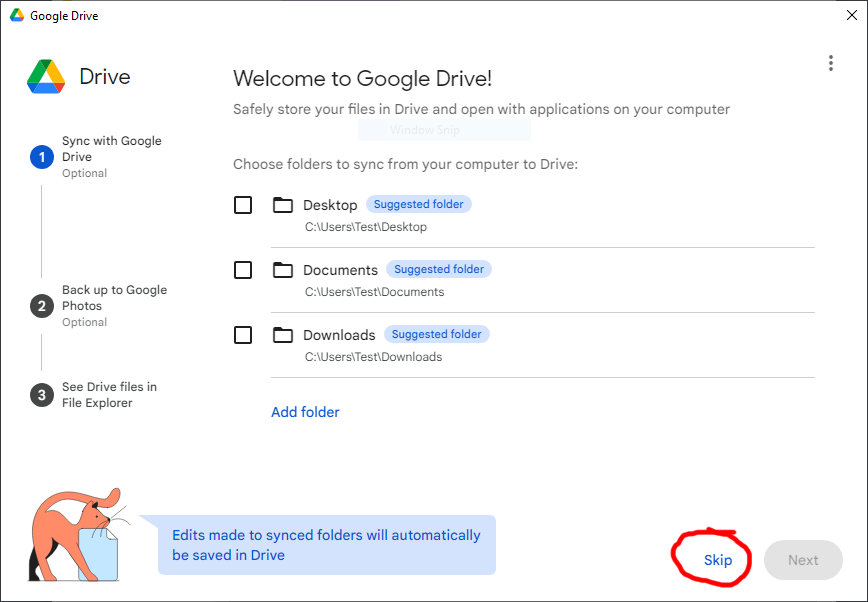
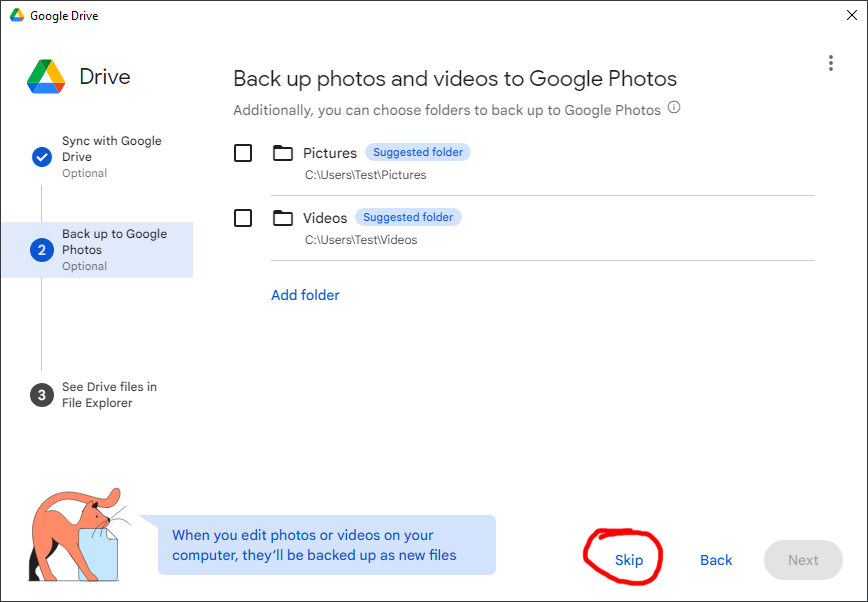
Google Drive (G:) in File Explorer
Once you have finished initial setup your Google Drive is visible in Windows File Explorer as a virtual drive (screenshot below). Default drive letter is G:, but in case you already had G: drive it may have some other letter. By default the drive is pinned for quick access, but if it is not then you can find the drive under “This PC” node.
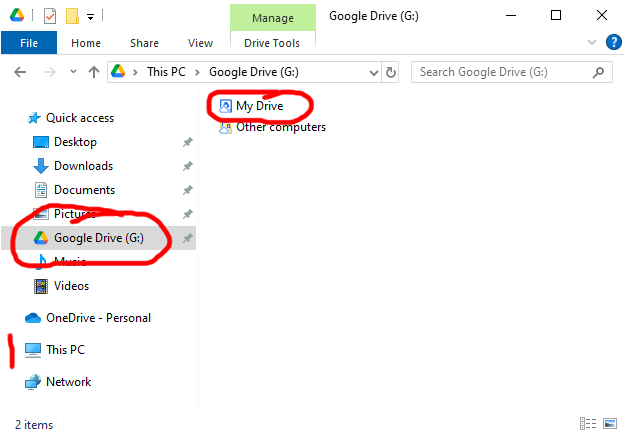
Moving your Password Agent data files to Google Drive
Open the root level “My Drive” folder on Google Drive. This folder can be empty or you may see your existing files/folders there.
Create new folder inside root level folder “My files” to store Password Agent files. On the screenshot below folder named “PWA” was created for this purpose. Of course you can name it like “Passwords”, but such naming gets more attention from potential passers by than is needed.
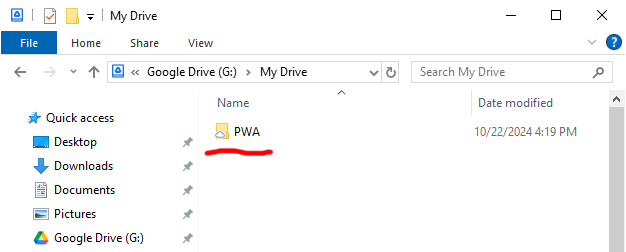
After new folder has been created you can make it available offline, then Google Drive will automatically keep this folder’s contents locally available, in case you have lost network connectivity. Also files load much more quickly if these are already downloaded before opening in Password Agent. Note: This setting is device/computer based, you need to mark this folder for offline use on each of your devices/computers where you want to have Password Agent files to be always available.
To make the Google Drive folder available offline right-click it to invoke context menu, then open sub-menu Offline access and select Available offline (see screenshot below). On Windows 11 you need to first invoke Show more options command from context menu, then additional Google Drive commands will be visible in context menu.
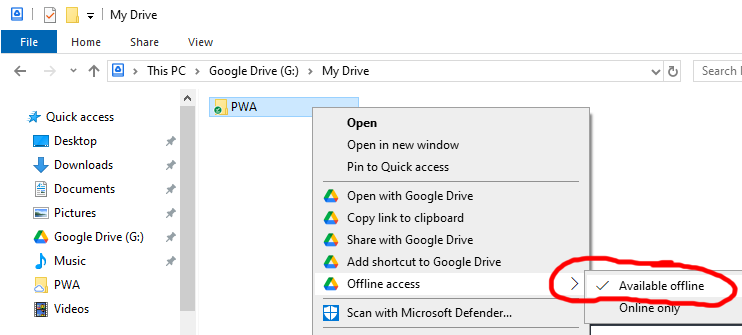
Now open your newly created folder and move* your Password Agent data file(s) from current location to the new folder on Google Drive. You can skip copying any .old files, which are automatically maintained older versions of the files – these slow down syncing. You cannot move file that is currently open in Password Agent, so close (not minimize) Password Agent before moving files. If you don’t know where your existing data files are located then please see Locating Password Agent data files.
*) Make backup of your files first, but in the end you need to have all files in one location to avoid situation where you mistakenly open and use same file from different source and will end up having seemingly same files with different content.
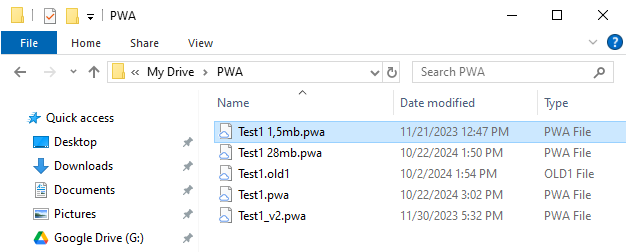
Open files directly form Google Drive (Windows)
Now when you have finished moving your files to Google Drive folder, you can open your files directly from Google Drive. In File Explorer double-click a data file residing on Google Drive to open it in Password Agent, or if you do not have file association, open a file from Password Agent using menu command File | Open (be sure to browse file from virtual drive G:).
In Password Agent file name is displayed on status bar along with last modification time (from version 2024.9.24, screenshot below). Confirm that you are using a file from Google Drive (letter G:). Since you earlier used file(s) from your local system, it is recommended that you now clean your old recently used files list in Password Agent, for this use menu command File | Open recent | Manage list | Remove all. If you do not clean it you may accidentally re-open wrong file (old version) from local system, instead of cloud drive, and keep using it without noticing.

Important! Google Drive software cannot update files that are open in Password Agent
It is important to remember that when you open (unlock) a file in Windows version of Password Agent then Google Drive software cannot update the open file locally if it has changed in the cloud (as long as the file is open). To get the update you need to lock unlocked file, then after some time the file gets updated. If you work with cloud files that are updated elsewhere, then you should configure Password Agent to lock open file(s) after inactivity period. For this open program settings and change User activity timeout to 10 (minutes, default) and User inactivity action to Lock open files (default).
To know if you have up to data file to open, inspect last modification time on status bar of Password Agent (screenshot above) – if you know the file has been modified in the cloud, but you still see older date then the local file has not been updated from the cloud. Do not edit the file until you get up to date copy, otherwise you will get file conflict and two different file versions. If the file is open then lock it and wait until it is updated by Google Drive software. The last modification time on status bar is updated automatically when file is updated.
File conflicts and older file versions
Using Password Agent with Google Drive requires some attention to not overwrite newer data file with older. If this or some other issue has risen then you can see older file versions kept by Google Drive.
Note: You may see .old1 etc files next to your data file, these are made by Windows version only. We are trying to get rid of them on cloud drives, with upcoming update. Now you can better use Google Drive means to recover older file version as that also includes changes made by Android version.
Open your Google Drive folder that contains Password Agent files, right-click a file to display context menu and choose menu command Manage versions (screenshot below). On Windows 11 you need to first invoke Show more options command from context menu, then additional Google Drive commands will be visible in context menu.

Another File Explorer window is opened, displaying available file versions. You can change view to details view to see file dates etc. You can open an old version directly in Password Agent, but the file will be read-only. If you would like to revert to that file then you need to copy it from there to original location and rename the file to its (original or other) name. Then open it from that new location for full read/write access.
Note: When you change master password due to security concern then file versions that can be accessed with previous password can be found in cloud file history, unless you manually delete these from cloud file history.
Accessing Google Drive from multiple computers
If you have multiple computers then you can now configure other computers to open file(s) from this Google Drive folder. Just install Google Drive for Desktop, optionally mark folder with Password Agent data files as available offline, then open data file directly from Google Drive and clean old recent files list.
Accessing Google Drive from Android app
See topic How to open file from cloud drive on Android.
Always use the latest version of Password Agent
As we continuously update and improve Password Agent compatibility with major cloud services it is recommended to use the latest version of the program for best results.